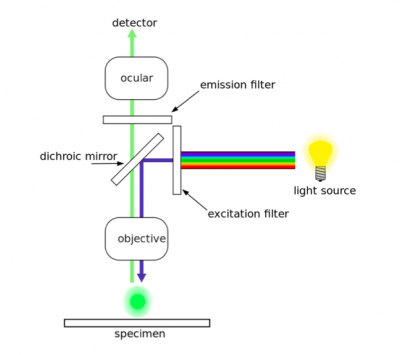20.109(F16):Data analysis (Day7)
Contents
Introduction
As a brief reminder, two antibodies were used in the gamma-H2AX assay. The first antibody, or primary antibody, was anti-gamma-H2AX and raised in a mouse. The secondary antibody was anti-mouse and raised in a goat, more importantly, this molecule is conjugated to a fluorescent dye tag called Alexa Fluor 488. The Alexa Fluor 488 tag is a bright, green fluorescent dye that is excited at 488 nm. To visualize the abundance of double-strand breaks in your H2AX assay samples, we will use fluorescence microscopy.
In fluorescence microscopy the specimen is illuminated with a wavelength of light specific to the excitation of the fluorescent tag used to target the feature of interest. The excitation wavelength is absorbed by the fluorescent tag, which causes it to emit light at a longer, less energetic wavelength. Typically, fluorescence microscopes used in biology are an epifluorescence type wherein a single light path (the objective) for excitation and emission detection as depicted in the diagram above.
Fluorescence, or epifluorescence, microscopes are composed of a light source, an excitation filter, a dichroic mirror, and an emission filter. The filters and the dichroic mirror are specific to the spectral excitation and emission characteristics of the fluorescent tag. To visualize fluorescence, light at the excitation wavelength is focused on the sample. The light emission from the sample is focused by the objective to a detector.
Today you will image the samples you tested using the gamma-H2AX assay and complete a short summary that qualitatively interprets the data.
Protocols
Part 1: Visualize H2AX assay results
- Aspirate the secondary antibody solution.
- To wash the coverslips, add ~500 μL of TBS per well and rock the plate back and forth, then aspirate.
- Repeat this step a total of two times.
- Add 500 μL TBS per well.
- Obtain a fine gauge (26 3/8) needle, a pair of tweezers, and four glass microscope slides from the front laboratory bench.
- Carefully press the tip of the needle against the benchtop to bend it into a right angle such that the beveled side of the needle is the interior angle.
- Use the 'hook' created in Step #4 to lift the coverslip from the bottom of the well, then use the tweezers to 'catch' the coverslip.
- In total, you only need to visualize two coverslips from the gamma-irradiated plate and two coverslips from the control plate. Therefore, you have several wells that can be used as practice.
- When you are confident with your ability to retrieve the coverslips from the wells, add 5 μL of mounting media to a glass microscope slide.
- Place the coverslip cell-side down on the mounting media on the microscope slide.
- The cell-side of the coverslide is the side that was facing up in the well of the plate.
- Complete Steps #5-7 for coverslips from two gamma-irradiated and two control wells.
- Alert the teaching faculty when all four microscope slides are ready and you will be escorted to the microscope in the Engelward laboratory.
Part 2: Data analysis for H2AX assay
Reagents
Next day: [[
Previous day: Complete immuno-fluorescence assay
